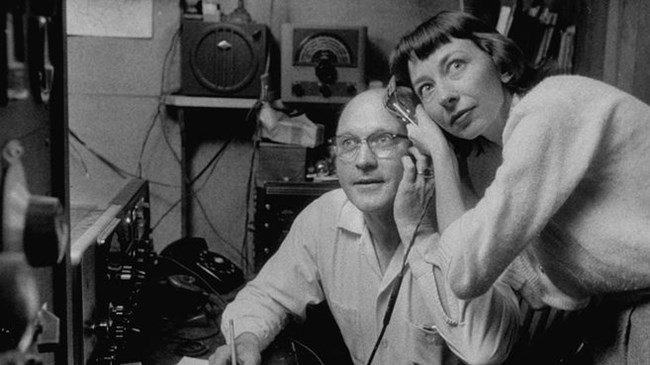Part of a series of articles titled Minuteman Missiles and the Nuclear Arms Race.
Article
The Shock of Sputnik

Francis Miller/LIFE
On October 4, 1957, the Soviet Union successfully launched into orbit the world's first artificial satellite, Sputnik. Ham radio operators in the eastern United States turned their dials to lower frequency bands and anxiously listened as the 184-pound Sputnik emitted a mechanical " . . . beep . . . beep . . . beep . . . " while passing overhead. Other radio operators quickly recorded the broadcast and, within hours, Americans in their living rooms heard Sputnik's transmission via radio and television news flashes. The message seemed to confirm America's worst fears: the Soviets had technologically surpassed the United States and gained supremacy of outer space. The Soviet scientific community wasted little time boasting about their apparent win. Immediately after the launch, one Muscovite scientist commented, "Americans design better automobile tailfins, but we design the best intercontinental ballistic missiles and earth satellites." In the United States, one headline proclaimed: "U.S. Must Catch Up with Reds or We're Dead."
In truth, the significance of the successful launching was not so much Sputnik, but the huge Soviet rocket that hurled the satellite into space. With Sputnik, which is Russian for "fellow traveler," the Soviets demonstrated the ability of their SS-6 launcher to propel a missile toward a target thousands of miles away. Four years earlier, the Soviets exploded the "H-bomb." Now, the frightening prospect of a Soviet missile delivering a nuclear bomb to an American city in less than an hour revived what some called a ''Pearl Harbor atmosphere'' throughout the United States. At the urging of his military advisors and under tremendous public pressure, President Dwight D. Eisenhower reluctantly accelerated America's ICBM program.
The shock of Sputnik abruptly reversed what Air Force Secretary Donald Quarles had characterized as America's "poor man's approach" to the ICBM program. Within six months after Sputnik, the Nation's space research and development budget mushroomed from an average half billion dollars a year to more than $10.5 billion. Much of the money went to the development of the Minuteman missile. In 1958, Congress increased the appropriation for Minuteman from $50 to $140 million. The following year, Congress added two billion dollars to the Minuteman budget, to be spread out over the next five years.
Sputnik sparked the development and deployment of the Minuteman missile. But the origins of the Minuteman missile program were deeply rooted in the years immediately following World War II - when the world's two superpowers began to engage in the spiraling arms race of the Cold War.
Last updated: October 20, 2020
